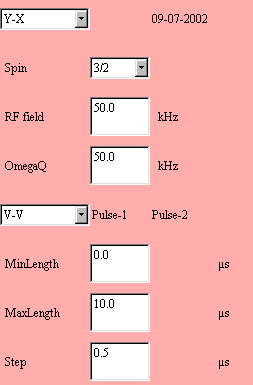AIM: Determination of the quadrupole coupling from a featureless NMR lineshape
Launch the spin-lock applet with Java Web Start.

Five spin-locking sequences (Y-X, SL1, SL2, SL3, and SL4) with various phase cyclings are presented in this applet. In the following pulse sequences, the RF phases are indicated in curly brackets, and acq(+y) means the FID is detected in the +y-axis of the receiver with quadrature phase.
|
Y-X: {+Y,+X}-acq(+y) SL1: {+Y,+X}-acq(+y) {-Y,+X}-acq(-y) SL2: {+Y,+X}-acq(+y) {-Y,+X}-acq(+y) |
SL3: {+Y,+X}-acq(+y) {-Y,+X}-acq(+y) {-X,+X}-acq(+y) {+X,+X}-acq(+y) SL4: {+Y,+X}-acq(-y) {-Y,+X}-acq(-y) {-X,+X}-acq(+y) {+X,+X}-acq(+y) |

The left part of the simulation panel indicates the physical parameters. It is preset for a typical experiment on a spin I = 3/2. You can introduce your own values.
First, we select one of the five spin-locking sequences with the upper choice box.
Then, we select one of the three types of line intensity
calculation with the lower choice box:
(1) V-V: when p1 = p2 and varying simultaneously;
(2) V-F: when p1 is variable and p2 is constant;
(3) F-V: when p1 is constant and p2 is variable.
When p1 = p2, only the parameters for p1 are required.
For V-F and F-V cases, the constant pulse-length should be provided in the MinLength field.
MinLength: the first variable pulse-length in µs
MaxLength: the last variable pulse-length in µs
Step: the increment of the variable pulse-length in µs
Depending on the spin-locking sequence used, the FID of the central transition is detected in one of the two channels in quadrature of the receiver. Therefore, after pressing the RUN button in the right part of the simulation panel (not shown), we use the check buttons to choose the real or the imaginary parts of the line intensity. In contrast, the satellite-transition signals are detected in both channels of the receiver.
As the rotary-echo sequences, these spin-locking sequences cancel signal with small or large quadrupolar couplings. Furthermore, Sequence SL4 also cancels the spurious signals as the composite-pulse sequence does.
The following applet is initialized for the central-line intensity of a spin I = 3/2 in a single crystal excited by the basic Y-X spin-locking sequence, where the pulse lengths p1 = p2 vary simultaneously from 0 to 10 µs by 0.5 µs step. The experimental line intensities are identical to the simulated ones.
Help for selecting all the simulated data of the line intensity text area in a JDK1.1.8 applet.
